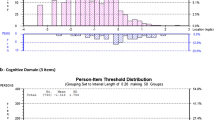Abstract
Objective: to evaluate the psychometric performance of a new human immunodeficiency virus/acquired immune deficiency syndrome (HIV/AIDS)-targeted quality of life (QoL) instrument in asymptomatic HIV-seropositive individuals. Methods: 201 urban and rural, HIV-seropositive subjects were recruited to complete a 76-item pilot QoL measure developed using content provided in group process by seropositive individuals. Questionnaire responses from the full sample (n=201) were used to identify dimensions and to reduce the number of items to 42. The responses to the retained items were then analysed for the asymptomatic subsample (n=106). Results: 9 multi-item dimensions were identified: overall function (OF), sexual function (SF), disclosure worries (DW), health worries (HW), financial worries (FW), HIV mastery (HM), life satisfaction (LS), medication concerns (MC) and provider trust (PT). The responses by asymptomatic subjects (74% male, 64% non-White and 63% homosexual/bisexual) revealed no substantial floor or ceiling effects, except for the PT dimension (where 44% were found to have scored the highest score). The internal consistency coefficients (Cronbach's alphas) were between 0.80 and 0.89 for six dimensions. The coefficients were lower for the SF (0.52), HM (0.67) and MC (0.48) dimensions. Construct validity assessments, using self-reported HIV disease-severity and sociodemographic variables, revealed some significant relationships (p≤0.05) for all dimensions except SF, MC and PT. Conclusions: the results suggested that five dimensions (OF, DW, HW, FW and LS) from the new instrument have good psychometric properties for asymptomatic HIV-seropositive individuals. These dimensions may be useful in the study of asymptomatic, seropositive individuals' QoL. Four dimensions (SF, HM, MC and PS) require additional refinement for this subpopulation.
Similar content being viewed by others
References
Williams JBW, Rabkin JG. The concurrent validity of items in the Quality-of-Life Index in a cohort of HIV positive and HIV-negative gay men. Control Clin Trials 1991; 12: 129S–1241S.
Wu AW, Rubin HR, Mathews WC et al. A health status questionnaire using 30 items from the Medical Outcomes Study: preliminary validation in persons with early HIV infection. Med Care 1991; 29: 786–798.
Lubeck DP, Fries JF. Changes in quality of life among persons with HIV infection. Qual Life Res 1992; 1: 359–366.
Schag CAC, Ganz PA, Kahn B, Petersen L. Assessing the needs and quality of life of patients with HIV infection: development of the HIV Overview of Problems-Evaluation System (HOPES) Qual Life Res 1992; 1: 269–276.
Wachtel T, Piette J, Mor V, Stein M, Fleishman J, Carpenter C. Quality of life in persons with human immunodeficiency virus infection: measurement by the Medical Outcomes Study instrument. Ann Intern Med 1992; 116: 129–135.
Cleary PD, Fowler FJ, Weissman J et al. Health-related QoL in persons with acquired immune deficiency syndrome. Med Care 1993; 31: 569–580.
Ganz PA, Schag CAC, Kahn B, Petersen L, Hirji K. Describing the health-related quality of life impact of HIV infection: findings from a study using the HIV Overview of Problems-evaluation System (HOPES). Qual Life Res 1993; 2: 109–119.
Bozzette SA, Hays RD, Berry SH, Kanouse DE. A perceived health index for use in persons with advanced HIV disease: derivation, reliability and validity. Med Care 1994; 32: 716–731.
Bozzette SA, Hays RD, Berry SH, Kanouse DE, Wu AW. Derivation and properties of a brief health status assessment instrument for use in HIV disease. J AIDS Human Retrovirol 1995; 8(3): 253–265.
Holmes W, Bix B, Shea J. SF-20 score and item distributions in a human immunodeficiency virus-seropositive sample. Med Care 1996; 34: 562–569.
Holmes WC, Shea JA. Anew HIV/AIDS-targeted quality of life (HAT-QoL) instrument: development, reliability and validity. Med Care 1998; (in press).
Moore CM. Group Techniques for Idea Building. 2nd edn. Vol. 9. Thousand Oaks, CA: Sage Publications, 1994.
Stewart DW, Shamdasani PN. Focus Groups: Theory and Practice, Vol. 20. Newbury Park, CA: Sage Publications, 1990.
Flesch RF. A new readability yardstick. J Appl Psychol 1948; 32: 221–233.
Centers for Disease Control. 1993 revised classification system for HIV infection and expanded surveillance case definition for AIDS among adolescents and adults. MMWR 1992; 41: 1–13.
Cunningham WE, Rana HM, Shapiro MF, Hays RD. Reliability and validity of self-report CD4 counts in persons hospitalized with HIV disease. J Clin Epidemiol 1997; 50: 829–835.
McHorney CA, Ware JE, Lu JFR, Sherbourne CD. The MOS 36-item short-form health survey (SF-36): III. Tests of data quality, scaling assumptions and reliability across diverse patient groups. Med Care 1994; 32: 40–66.
Cronbach LJ. Coefficient alpha and the internal structure of tests. Psychometrika 1951; 16: 297–334.
Thorndike EL. A constant error in psychological ratings. J Appl Psychol 1920; 4: 25–29.
Carpenter CCJ, Fischl MA, Hammer SM et al. Antiretroviral therapy for HIV infection in 1996: recommendations of an international panel. JAMA 1996; 276: 146–154.
Author information
Authors and Affiliations
Rights and permissions
About this article
Cite this article
Holmes, W.C., Shea, J.A. Performance of a new, HIV/AIDS-targeted quality of life (HAT-QoL) instrument in asymptomatic seropositive individuals. Qual Life Res 6, 561–571 (1997). https://doi.org/10.1023/A:1018464200708
Issue Date:
DOI: https://doi.org/10.1023/A:1018464200708




